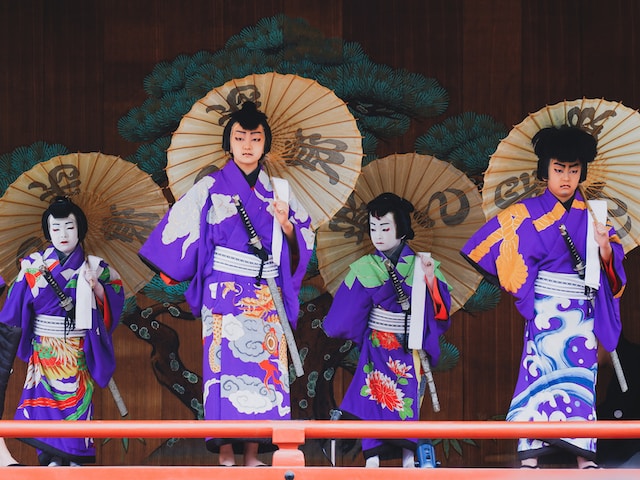Fearsome masks, silken costumes and the refreshing tones of exotic instruments draw people in to traditional Japanese theatre. Though some ancient forms such as noh, kabuki and bunraku can be difficult for outsiders to grasp, their timeless themes such as clan warfare, servant-master loyalty and revenge remain universal themes that transcend their origins.
Kabuki is known for its extravagant displays; eye-catching make-up and outrageous wigs play just as vital a part as actors’ deft movements in bringing its story alive.
Kabuki
Kabuki, or Kabuki Theatre, dates back to the early 1600s in Japan and features elaborate makeup and costumes, traditional Japanese music, an all-male cast (with male actors trained as “onnagata”) playing female roles; unlike noh, which requires hereditary acting talent, most kabuki actors and actresses learn their craft themselves through self-teaching.
The Kabuki stage features special features like revolving platforms and trapdoors to facilitate rapid scene changes and the swift entrance/exit of actors. A walkway called hanamichi connects audience seats, enabling dramatic entrances/exits by actors.
Although originally seen as entertainment, Kabuki could also serve as a serious commentary on contemporary society and actual historical events were dramatized within it; Chushingura (1748) for instance is an accurate recreation of how 47 ronin avenged their master’s death by revenge killings.
Kabuki has evolved into a complex art form with an emphasis on virtuosity, but the acting style differs significantly from that of Western theater. Kabuki actors employ exaggerated movements in their posture to produce powerful movement sequences. Furthermore, unique walking techniques like Roppo are employed – these mirror the fast and acrobatic fighting styles found in Chinese opera; additionally Hengemono plays are frequently performed, where one main character performs several roles at once.
Noh
Noh is a disciplined art form with distinct features that set it apart from western theatre: no curtain separates audience from stage; the sets are sparse; actors wear elaborate masks. Noh differs from kabuki in that its main goal is not plot-driven storytelling but to convey feelings of profound beauty instead; through slow movements by performers and instruments creating an atmosphere conducive to in-depth contemplation.
Noh is a Japanese performance art that features a four-piece musical ensemble comprising traditional Japanese drums, bass guitar, lute and flute called the nakan (). Clay pots placed beneath wooden stages amplify sound of footsteps as well as musicians playing instruments; Noh requires extensive training from its performers, who generally start their careers around age three – learning different roles while deciphering musical accompaniments to interpret meaning in Noh performances.
Noh performances typically begin with a priest or other secondary character in long dark robes entering the stage and describing an event for audiences to imagine, before introducing their main character who acts out the scenario described. Other characters frequently speak dialogue with them.
Kyogen
Kyogen theatre has long been a part of Japanese tradition. A spoken comedy drama, it is easy for non-Japanese audiences to follow. Bright characters engage the audience through funny dialogue and unusual movements; Kyogen used to be part of Noh but later developed into its own genre in 16th century; now considered highly respected artform worldwide.
Kyogen was originally developed from Noh’s humorous forms known as “sarugaku”, performed between Noh dramas as an interlude of light humor that provided an escape from its seriousness. Kyogen flourished further during the Heian period with its emphasis shifting more heavily toward comedy while still including some elements from its predecessor sangaku such as acrobatics or juggling.
Later on, Kyogen became more fully developed and was sometimes shown as its own show. Today there are two active schools of Kyogen: Okura and Izumi schools. Their combined repertories feature over 260 plays – such as Taro kaja and Jiro kaja who eat their master’s tangerines despite orders not to. Kyogen dramas tend to be short with many stock characters like these featured such as servants Taro kaja and Jiro kaja who regularly break orders from their master even when told not to do so!
As with Noh, Kyogen actors are generally male and wear unique costumes to distinguish themselves as actors in particular roles. Additionally, expressive speech and large movements help convey emotion effectively.
Bunraku
Bunraku (ningyo joruri) is one of the three major classical theaters in Japan and is considered by many to be among the world’s most highly developed forms of puppet theater. Puppets typically range in size between one-half to two-thirds life size and are operated by three highly trained performers who remain hidden to the audience while each specialising in one area of operation for their puppet. The main puppeteer (omozukai) handles the head and right arm of a character, while two additional puppeteers (hidarizukai and ashizukai) operate their left hands to control left-handed puppets and legs respectively. All three puppeteers operate within an established hierarchy which regulates their interactions both between themselves as well as with an audience.
Bunraku plays are inspired by historical events, folk tales about heroes and heroism, feudal wars, and love stories between commoners during the Edo period. Bunraku’s most widely performed repertoire consists of twenty-four “domestic tragedies” by Chikamatsu Monzaemon; many of these plays explore social obligation, personal longings/passions or suicide; one famous play being Sonezaki Shinju (Double Suicide at Sonezaki), which was inspired by real events.
Though performers are an integral component of this performance, the focus lies squarely with the puppets themselves. Each puppet features exquisite craftsmanship and can often display human-like emotions, actions and even breathing. Puppeteers wear black robes as a signifier that they wish to remain unnoticed by audiences.

